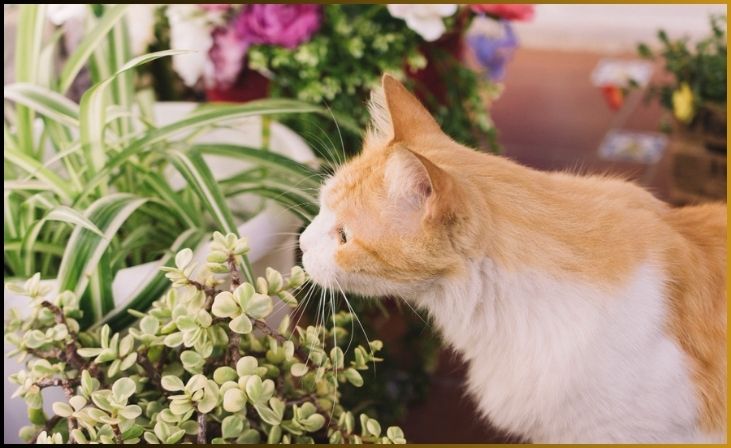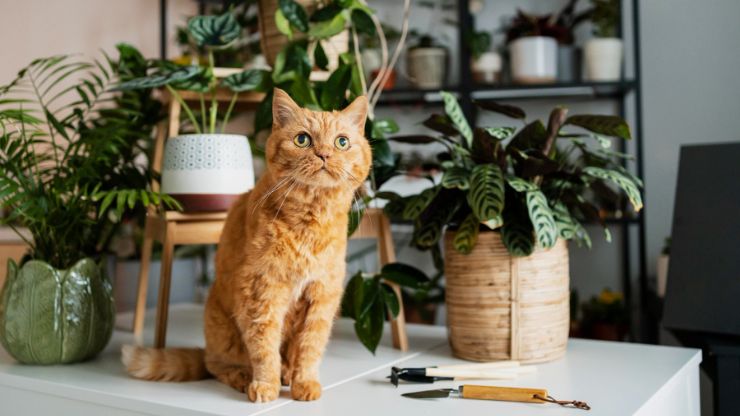Creating a cat-friendly haven involves more than just providing toys and scratching posts. One way to enhance your feline friend’s environment is by incorporating plants that they can safely interact with and enjoy. In this guide, we will explore seven cat-friendly plants that not only add beauty to your home but also provide mental stimulation and health benefits for your feline companion. These plants are non-toxic and offer a safe and enriching experience for your curious cat. Let’s dive into the world of plants that your feline friend will love!
Table of Contents
ToggleBest Cat-Friendly Haven

Cats bring joy and warmth to our homes, and as pet owners, it’s our responsibility to ensure their safety and happiness. One way to do this is by introducing cat-friendly plants into your living space. These plants not only brighten up your home but also provide entertainment and stimulation for your furry companions. Let’s explore seven such cat-friendly plants that are safe and enjoyable for your cats.
1. Spider Plant (Chlorophytum comosum)
Embrace the charm of the Spider Plant, a beloved choice for cat owners. Its arching green leaves, adorned with distinctive white stripes, not only enhance your space visually but also offer a safe haven for your feline friend. The long, arching leaves become an intriguing playground for cats, enticing them to bat and play without posing any harm. This dual-purpose plant not only adds aesthetic appeal but also contributes to your cat’s mental stimulation, creating an environment where entertainment and safety seamlessly intertwine. Ensure this delightful addition to your home receives adequate indirect sunlight and regular watering, making it a perfect harmony of aesthetics and feline-friendly features.
2. Catnip (Nepeta cataria)
Discover the enchanting world of Catnip, celebrated for its captivating effects on our feline friends. More than just safe, Catnip serves as a wellspring of entertainment and stimulation for cats. Whether they’re rolling in it, chewing on its leaves, or simply reveling in its aromatic allure, Catnip transforms into a natural playground for your beloved pet. This botanical wonder doesn’t just provide joy but also triggers a range of playful behaviors, making it an invaluable addition to your home. Ensure a steady supply of fresh Catnip to keep your cat engaged and delighted, creating an environment where the simple joy of nature enriches your cat’s daily life.
3. Mint (Mentha)
Embrace the delightful presence of mint, particularly varieties like peppermint and spearmint, known to be safe for your feline companions. Beyond its safety, mint adds a fragrant touch to your garden or indoor space. The versatility of mint extends to shared experiences—you can use its leaves to craft herbal teas for yourself while providing an engaging environment for your cat to explore. This harmonious interaction creates a win-win scenario, where the aromatic allure of mint enhances both your moments of relaxation and your cat’s sensory adventures. Cultivate a vibrant space where the benefits of mint extend beyond its aromatic charm, fostering shared enjoyment in your home.
4. Basil (Ocimum basilicum)
Introduce the versatility of basil, celebrated for its aromatic leaves, into your living space—a choice both safe and intriguing for your feline companions. Consider placing a small potted basil plant in your kitchen, creating an aromatic haven that captures your cat’s curiosity. While the aroma of basil may captivate your pet, exercise caution to ensure they don’t indulge in excessive nibbling. Strike a balance between the sensory appeal for your cat and responsible ownership, allowing the presence of basil to add a touch of nature to your home without compromising your cat’s well-being. With this aromatic addition, create a harmonious environment where the essence of basil enhances your culinary moments and sparks interest for your inquisitive feline friend.
Don't just scroll, subscribe!
BuzzTrail's unique web-stories are the cure for boredom you've been waiting for.
Quick link: Top 10 Tips for Caring for Cats and Kittens: A Guide to Happy and Healthy Feline Companions
5. Lavender (Lavandula)
Elevate your space with the soothing allure of lavender, renowned for its calming and delightful fragrance—a safe and enchanting addition to both your garden and home. The aromatic blooms of lavender not only enhance the visual appeal but also contribute to a tranquil atmosphere. While cats might occasionally display interest in the lavender, rest assured that it is non-toxic and poses no harm to them. Embrace the harmonious coexistence of nature and pets, as the lavender’s gentle presence creates an environment where beauty, fragrance, and the well-being of your feline companions seamlessly converge. Cultivate a serene haven where the calming essence of lavender enriches both your surroundings and the experiences of your beloved cats.
6. Rosemary (Rosmarinus officinalis)
Invite the aromatic charm of rosemary into your culinary and living space—a delightful herb celebrated for its woody scent and distinctive flavor, captivating not only for humans but also safe for our feline friends. The unique appeal of rosemary extends to its safety for cats, making it an excellent addition to your kitchen or garden. However, exercise caution to prevent your curious cat from adopting it as a chewing toy. Strike a balance between enjoying the culinary benefits of rosemary and ensuring responsible pet ownership, creating an environment where the aromatic essence of this herb adds flavor to your dishes while prioritizing your cat’s well-being.
7. Calendula (Calendula officinalis)
Embrace the vibrant and cheerful presence of calendula, a flower not only safe but also beneficial for your feline companion’s well-being. Known for its healing properties, calendula serves as more than just a visual delight; it can be incorporated into topical treatments. While your cat may not exhibit a particular interest in it, the lively blooms add a lovely touch of color to your home, creating an environment where aesthetics and holistic benefits seamlessly converge. Cultivate a space where the vibrancy of calendula enhances both the visual appeal of your surroundings and the potential well-being of your cherished feline friend.
Bottom Line
Creating a cat-friendly haven involves considering your feline friend’s natural instincts and providing them with an environment that nurtures their well-being. By incorporating cat-friendly plants into your home, you can enhance their mental stimulation and offer a safe and enriching experience. From catnip to spider plants, these non-toxic plants not only add beauty to your home but also provide numerous benefits for your curious cat. Remember to monitor your cat’s behavior and consult with a veterinarian if you have any concerns. Create a vibrant and stimulating space for your feline companion with these seven cat-friendly plants they will surely love.
FAQs
What benefits do cat-friendly plants offer beyond aesthetics?
What benefits do cat-friendly plants offer beyond aesthetics?
Cat-friendly plants not only beautify your space but also serve as natural stimulants for your feline friend. Many plants provide mental and physical enrichment, creating a more dynamic and engaging environment for your cat.
How can I ensure the chosen plants are safe for my cat?
How can I ensure the chosen plants are safe for my cat?
Prioritize cat-safe plants by consulting reliable sources on pet-friendly flora. Avoid toxic varieties and place plants in areas inaccessible to your cat. Vigilance and awareness are key to creating a safe and enjoyable plant-filled haven.
Can I grow these plants indoors, and how do I care for them?
Can I grow these plants indoors, and how do I care for them?
Yes, many cat-friendly plants thrive indoors. Provide adequate sunlight, water, and suitable soil. Tailor care based on each plant’s specific needs, creating an indoor oasis that aligns with your cat’s well-being.
What signs indicate that a plant might be toxic to my cat, and what should I do if they show symptoms of poisoning?
What signs indicate that a plant might be toxic to my cat, and what should I do if they show symptoms of poisoning?
Signs of plant toxicity include vomiting, lethargy, and loss of appetite. In such cases, contact your veterinarian immediately. Familiarize yourself with emergency procedures and keep the contact information of a 24-hour animal poison control center readily available.

